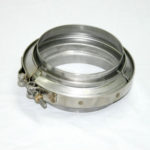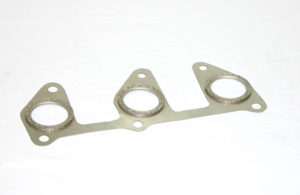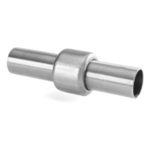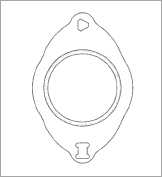High Temperature Seal Gaskets
Static Flange Gaskets
High-Temperature-Resistant, Static Metal Gaskets for Demanding Exhaust Applications Gaskets for Demanding Exhaust Applications
 High temperature seal gaskets from Metal Textiles create a secure seal under extremely low and high temperatures and in demanding corrosive environments. Metal Textiles static flange gaskets can provide:
High temperature seal gaskets from Metal Textiles create a secure seal under extremely low and high temperatures and in demanding corrosive environments. Metal Textiles static flange gaskets can provide:
- Zero leakage at pressures of up to 2 Bar
- Recovery after compression of 90%
- Minimum sealing stress of 10N/mm2
- Temperature resistance from -50° C to 800° C
- Cross section from 4 mm to 8 mm
- Inside diameters from 38 mm to 127 mm
- Custom cross-sections and ID also available
Exhaust System Sealing Technology that Keeps Pace with Emission Regulations
As the automotive industry continues to keep pace with new emissions regulations, the requirements of exhaust system joints become increasingly demanding. These joints must not only prevent the release of untreated exhaust gas, they must also combat ingestion of oxygen into the exhaust system-which can have adverse effects on the closed-loop emission control system.
To meet these stringent demands, Metal Textiles engineers have developed a system approach to joint design, and coupled that with advances in seal and gasket materials, geometry, and construction.
An all-metal ring gasket that improves performance
A thin metal jacket fully encapsulates a knitted wire mesh core. This all-metal construction eliminates filler material burn-out and provides far greater resiliency over traditional automotive flange gaskets-even at elevated temperatures. In addition, all component materials can be custom-tailored to achieve further gains in resiliency. The gasket is designed to fit into a groove in the flange, with the groove depth sized to limit ring compression, allowing the gasket to operate in a set portion of the compression/recovery curve.
- Designed for installation between two geometrically identical flanges welded to adjacent system components.
- The slight oval shape of the gasket locks firmly into the flange groove or around the pipe’s OD during assembly.
- The seal is constructed of a stainless steel foil ring with a round, rectangular, or oval cross-section formed around a resilient knitted wire mesh core.
- This durable seal has unique spring-back properties and, due to its all-metal design, is ideal for high-temperature and high-corrosion environments.
- Available with a sheet-metal carrier which fits over the studs that hold the gasket in place in order to seal the joints created when two flat flanges are rigidly bolted to one another. The carrier portion of this gasket is typically 0.2 mm thick and usually matches the shape of their companion flanges.
PRODUCT BENEFITS
- Resilient-maintains seal between flanges for leak-free performance
- High Temperature- core maintains resiliency at extreme operating temperatures
- Durable-all stainless steel construction fights corrosion
- Reusable
- Simplified Installation- slight oval shape of gasket locks firmly into flange groove or around pipe OD during assembly. Sheet metal carrier fits over studs, holding gasket in place.
Exhaust Seals and Exhaust Gaskets
Knitted Wire Mesh Exhaust Seals and Gaskets for Superior Performance in Harsh Environments
 Metal Textiles knitted wire mesh exhaust seals and exhaust gaskets provide resiliency, strength in compression, and a nearly unlimited choice of materials, constructions, or shapes for specific applications. Most important, they provide superior performance in hostile environments where other materials would fail as a result of decomposition or deformation.
Metal Textiles knitted wire mesh exhaust seals and exhaust gaskets provide resiliency, strength in compression, and a nearly unlimited choice of materials, constructions, or shapes for specific applications. Most important, they provide superior performance in hostile environments where other materials would fail as a result of decomposition or deformation.
Knitted mesh exhaust seals have no seams or ribs—normally the weak areas of any seal—so that when used in gasketing and sealing applications, they provide high-strength uniformity throughout the sealing area. Unlike woven or braided materials, knitted mesh consists of a continuous series of interlocking loops knitted in a tubular form, allowing two-dimensional movement in the plane of the mesh. This results in unusual flexibility and resiliency, even under heavy compression loads and exposure to extreme temperatures.
Due to its inherent resiliency and strength in compression, knitted wire mesh also yields to applied force—yet recovers to nearly its original shape when the force is removed.
Flexibility in Design and Performance
 When knitted mesh is combined with other materials, the mesh serves as a “backbone” support imparting resiliency and strength in compression to the seal. Because of the wide array of materials available for construction, knitted wire mesh can also be used to create any number of flexible, resilient gasketing or seal configurations over a broad range of operating conditions.
When knitted mesh is combined with other materials, the mesh serves as a “backbone” support imparting resiliency and strength in compression to the seal. Because of the wide array of materials available for construction, knitted wire mesh can also be used to create any number of flexible, resilient gasketing or seal configurations over a broad range of operating conditions.
Knitted wire mesh seals and gasketing may be used for static joints, as well as those where there is freedom of positioning in repeated closures. In all of these applications, conventional materials require periodic replacement. Even where replacement can be scheduled well in advance of the estimated failure point, replacement cost and downtime are high.
Seals and Gaskets that Offer Flexibility, Strength, High-Temperature Resistance… And Long-Term Performance
Depending on the specific application, knitted wire can be fabricated from almost any material or combination of materials that can be drawn into wire or filament form. For extreme environments, the most frequently used material is stainless steel wire.
Other ductile metals, such as aluminum, copper and special alloys, can also be used-as well as synthetic fibers, polymers and yarns-as either single substrates or configurations of multiple materials. This wide range of material options permits flexibility in producing gaskets that can be expressly designed for specific critical applications.
Sealing for some of the world’s harshest environments
 Metal Textiles has also developed a family of seals which combine knitted wire mesh technology with a variety of other materials to form unique composites. The resulting composite seals exhibit characteristics which can be useful in extremely harsh, chemical-process system environments. These seals are generally die-formed to fit specific applications within allowable tolerances. Available composite materials include graphite, ceramics, and other similar fillers.
Metal Textiles has also developed a family of seals which combine knitted wire mesh technology with a variety of other materials to form unique composites. The resulting composite seals exhibit characteristics which can be useful in extremely harsh, chemical-process system environments. These seals are generally die-formed to fit specific applications within allowable tolerances. Available composite materials include graphite, ceramics, and other similar fillers.
Typical applications include process valve shaft and stem seals where sealability is required along with seal resiliency, and temperature and corrosion resistance. Due to these performance characteristics, Metal Textiles seals are also commonly used in many other applications and industries, including petroleum and petrochemicals.
Metal Textiles also has the unique capability to integrate elastomers and plastics with knitted wire mesh technology for extremely hostile-environment applications-including the kinds of sealing problems encountered with temperatures to 260°C and pressures to 138 MPa.
The unique characteristics of knitted wire mesh construction provide the necessary resilience and mechanical strength to restrict extrusion of the most free-flowing materials while maintaining excellent memory.
The unique fabrication process used by Metal Textiles makes possible the production of seals, gaskets, and gland packings in forms, shapes and densities unobtainable by any other method or material. This process allows the creation of sealing media for virtually any application.
Ring Gasket with Heat Shield*
High-Temperature Flange Gasket with Integral Heat Shield for Thermal Protection of Sensitive Components
 The Metal Textiles Ring Gasket with Heat Shield represents the next evolution in our all-metal gasket technology by bringing together the unique, zero-leak performance characteristics of our knitted wire mesh static flange gaskets with built-in heat protection in a single, all-metal gasket assembly.
The Metal Textiles Ring Gasket with Heat Shield represents the next evolution in our all-metal gasket technology by bringing together the unique, zero-leak performance characteristics of our knitted wire mesh static flange gaskets with built-in heat protection in a single, all-metal gasket assembly.
The result is optimal thermal protection for sensitive automotive components such as on-board computer sensors—all with greater ease of installation and overall system integrity. Combining the gasket and heat shield in one integrated unit offers a number of significant advantages in automotive manufacturing:
- Simplified Assembly— with greater speed and ease of assembly, our unique single piece gasket/shield design eliminates the need to bolt, weld or strap the heat shield in place.
- Reduced acquisition costs— The unit not only cuts labor and component costs but reduces inventory management by eliminating additional part numbers.
- Cost-effective performance— zero leakage and thermal protection in one product to protect sensitive automotive components.
As with our static flange gaskets, all gasket components are designed with a retention feature which ensures that each unit remains in place during the assembly process. In addition, the grooved static mating flange protects sealing elements from over-compression and helps guarantee flange-to-flange contact.
Custom solutions to meet any sealing/thermal-protection need
Finite Element Analysis and CAD are used throughout the development process to optimize design and functionality. Vibration and leak testing are also conducted to ensure high-performance, leak-free joints.
Exhaust System Sealing Technology that Keeps Pace with Emission Regulations
 As the automotive industry continues to keep pace with new emissions regulations, the requirements of exhaust system joints become increasingly demanding. These joints must not only prevent the release of untreated exhaust gas, they must also combat ingestion of oxygen into the exhaust system-which can have adverse effects on the closed-loop emission control system.
As the automotive industry continues to keep pace with new emissions regulations, the requirements of exhaust system joints become increasingly demanding. These joints must not only prevent the release of untreated exhaust gas, they must also combat ingestion of oxygen into the exhaust system-which can have adverse effects on the closed-loop emission control system.
To meet these stringent demands, Metal Textiles engineers have developed a system approach to joint design, and coupled it with advances in seal and gasket materials, geometry, and construction.
An all-metal ring gasket that improves performance
A thin metal jacket fully encapsulates a knitted wire mesh core. This all-metal construction eliminates filler material burn-out and provides far greater resiliency over traditional automotive flange gaskets-even at elevated temperatures. In addition, all component materials can be custom-tailored to achieve further gains in resiliency.
The gasket is designed to fit into a groove in the flange, with the groove depth sized to limit ring compression, allowing the gasket to operate in a set portion of the compression/recovery curve.






Recent Comments